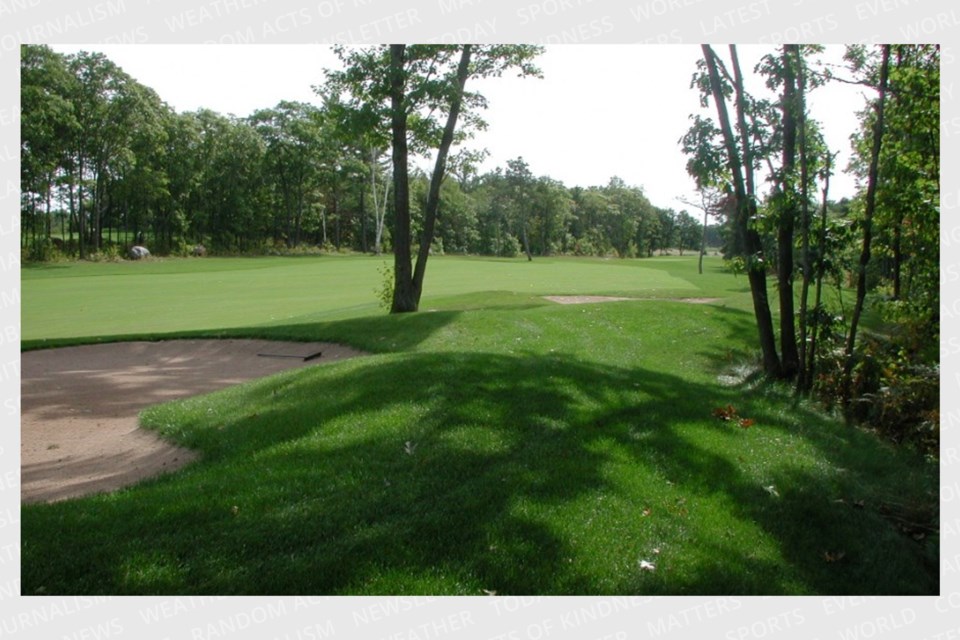Golfers have probably already noticed a slight change while hitting the fairways at Huron Pines Golf and Country Club this season.
This past spring, two wooded areas at the golf course owned by the Town of Blind River were entirely fenced off — an act of reconciliation after council there was informed by neighbouring Mississauga First Nation that the areas are part of an ancient Anishinaabe site where a number of burial mounds are situated.
“Our history works through oral tradition, so we’ve always been told of the golf course area and how important it is,” said Mississauga First Nation Chief Brent Niganobe, who made the presentation to council in Blind River earlier this year. “We’ve always known that the burial mounds were there.”
Niganobe says historical impacts to Indigenous Peoples, such as colonization and the residential school system, placed his First Nation in a tough spot where it was in no position to address the burial site with the Town of Blind River in years past.
“Obviously there were some who were not aware of the historical impacts and what had happened there, so I think them being educated on it, and them being open to it — and it being on public record now — is a positive thing,” the chief said.
A working group consisting of representatives of Mississauga First Nation and Blind River has been established following the chief’s presentation to council.
“We’re lucky that Chief Niganobe gave a presentation to council, so that we can understand the story to be told from Mississauga First Nation’s lens — it’s their lens, not our lens — and of course we want to do everything we can to make sure that we acknowledge that the burial grounds are there, and to educate the public that we need to be respecting this area of the golf course,” said Blind River Mayor Sally Hagman. “We have such a great relationship with Mississauga First Nation in both our operations and our governance area. We want to make sure we’re doing the right thing.”
The working group will be tasked with putting together an “educational component” to inform the public of the history of the Anishinaabe burial grounds and their significance, says Hagman.
“We are definitely wanting to work with Mississauga First Nation to ensure that the respect is given to the land, and we give that respect each and every time we have a land acknowledgement,” she said. “We are very, very fortunate that our communities work together to ensure that going forward, the right things are being done for the right reasons.”
The burial grounds at the golf course goes hand in hand with a larger effort to reclaim pieces of Mississauga First Nation’s past.
Niganobe says that “shabbily done” archaeological work conducted during the 1970s and 1980s led to the identification of historical Anishinaabe sites, with some human remains and other artifacts being mistakenly claimed and placed in museums.
In all, 16 such sites have been identified by Mississauga First Nation in its research — the burial grounds at the golf course, along with 15 other “sites of known occupation,” according to Niganobe.
And yet, just three of those sites were actually registered by archaeologists. “That was something that we came across as significant — for whatever reason, these sites were not properly documented,” the chief said.
One of the 16 sites was a ceremonial site where a traditional lodge once sat. But because the archaeologists didn’t identify that site, says Niganobe, the lodge itself was "plowed over."
“Those sites are important, and we don’t want to see that type of thing happen again,” he said. “There is use for those sites and we can learn from them, but unfortunately a site like that was destroyed. Those sites we still see as important.”
The First Nation has accessed funding from the Social Sciences and Humanities Research Council in order to conduct its own research on the sites in conjunction with the University of Toronto. “We’re not digging the burial mounds or anything like that,” Niganobe said. “We’re just working on the preservation of those sites, and making sure that they are properly cared for in the future.”
Mississauga has also partnered with the Canadian Museum of History and the Ojibwe Cultural Centre on Manitoulin Island in order to repatriate both human remains and artifacts back to the First Nation.
“We know we can do the right thing of repatriating those back to the First Nation, and put them back in the resting spot where they deserve to be,” Niganobe said.
The chief believes that after years of enduring historical impacts, there is now more of a willingness to learn about the history of Mississauga First Nation.
“We’re not well known or written about, so we’re trying to change that,” he said.
